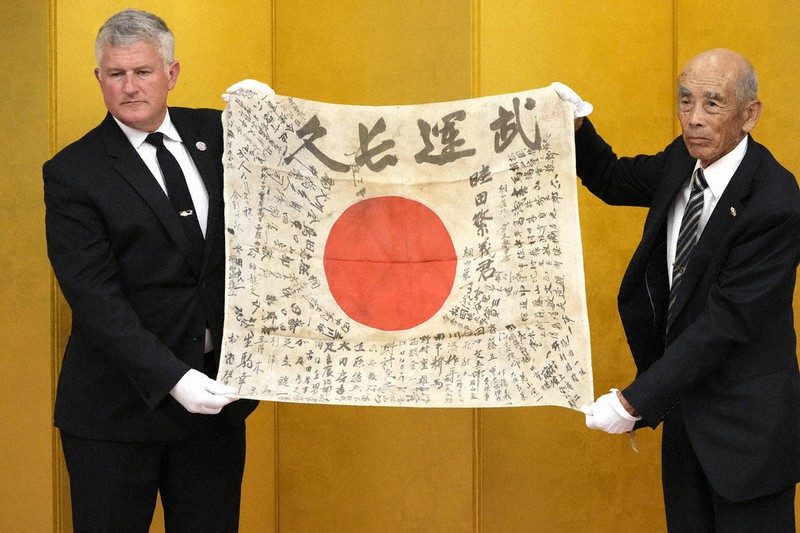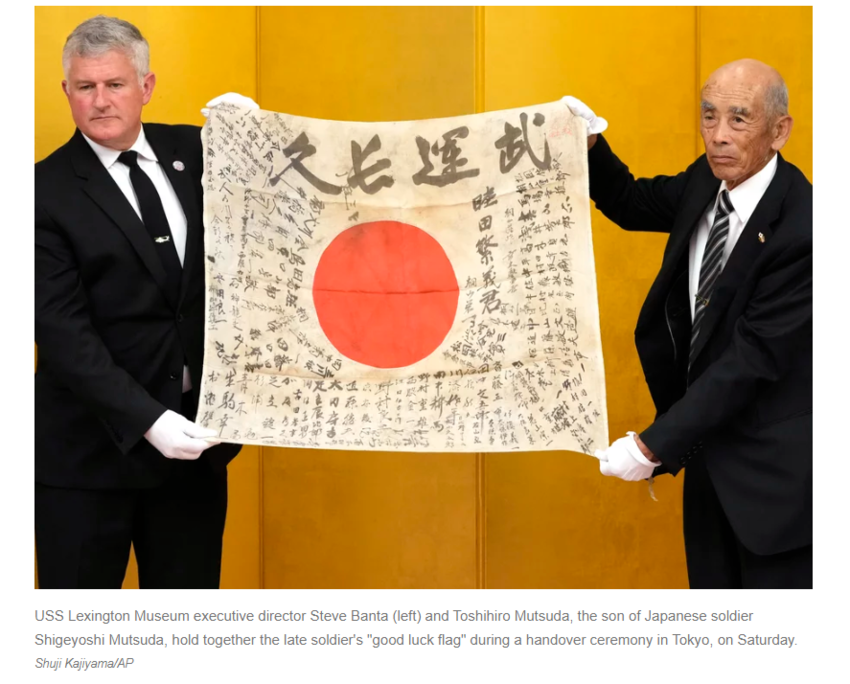

父の日章旗 米博物館から遺族に返還
80年ぶり再会 靖国神社で
太平洋戦争でサイパンに出征し、戦死した岐阜県出身の旧日本兵、 陸田むつだ 繁義さんのものとみられる日章旗が米国の博物館で保管されていることがわかり、千代田区の靖国神社で29日、遺族に返還された。約80年ぶりに戻った父の遺品を受け取った長男の敏弘さん(82)は「奇跡的なこと。うれしい気持ちで胸がいっぱい」と喜んだ。
日章旗には「武運長久」の文字や陸田さんと思われる名前のほか、家族や近所の人など数十人の名前が寄せ書きされている。敏弘さんらによると、陸田さんは1943年、26歳で陸軍に召集され、44年にサイパンに出征したといい、その際に日章旗を持参したとみられる。
今春、退役した空母を改装した米テキサス州の「航空母艦レキシントン博物館」にこの日章旗が展示されていることを知った敏弘さんの長男が、旧日本兵が戦地に持参した遺品の返還に取り組む米国の民間団体「OBON(オボン)ソサエティ」に相談。出征前に撮影された写真に写った旗と、博物館に展示された旗の特徴が一致することが確認され、返還が実現した。
(A Japanese flag believed to belong to Shigeyoshi Rikuta Mutsuda, a former Japanese soldier from Gifu Prefecture who was killed in action in Saipan during the Pacific War, was returned to his bereaved family at Yasukuni Shrine in Chiyoda Ward, Tokyo, on March 29. Toshihiro, 82, the eldest son of Shigeyoshi's father, who received his father's belongings back for the first time in 80 years, said, "This is miraculous. I am filled with happiness.
On the Yosegaki flag, there were inscriptions of the words "Bu-un Choukyu" (Long Live the Warrior), the name of a person believed to be Mr. Rikuda, and dozens of other names, including family members and neighbors. According to Toshihiro and others, Mr. Rikuda was drafted into the Army in 1943 at the age of 26 and went to Saipan in 1944.
This spring, Toshihiro's eldest son learned that the flag was on display at the Aircraft Carrier Lexington Museum in Texas, a renovated retired aircraft carrier, and consulted the OBON Society, a private U.S. organization that works to return artifacts brought to war by former Japanese soldiers. It was confirmed that the flag in the photograph taken before his departure for war matched the characteristics of the flag displayed at the museum, and its return was realized.)
29日に靖国神社で行われた返還式には、敏弘さんのほか、長女の美佐子さん(81)、次男の靖則さん(80)も岐阜県から駆けつけた。来日した同博物館のスティーブ・バンタ館長から日章旗を受け取ると、敏弘さんらは頬をすり寄せ、父との「再会」に感激した様子だった。
2018年に亡くなった陸田さんの妻、まさ江さんは毎年靖国神社を参拝し、夫の遺品が戻らなかったことを嘆いていたという。敏弘さんは「最も喜んでいるのは母だと思う。墓前に父の帰りを報告したい」と話していた。
(In addition to Toshihiro, his eldest daughter Misako (81) and second son Yasunori (80) also came from Gifu Prefecture to attend the restitution ceremony held at Yasukuni Shrine on March 29. Toshihiro and his family rubbed their cheeks together as they received the Japanese flag from Steve Banta, the museum's director, who had visited Japan, and seemed thrilled to be "reunited" with their father.
Masae Rikuda's wife, Masae, who passed away in 2018, visited Yasukuni Shrine every year and lamented the fact that her husband's belongings had not been returned. Toshihiro said, "I think it is my mother who is most pleased. I want to report my father's return to the graveside.")
https://www.yomiuri.co.jp/.../news/20230729-OYTNT50200/
![USS Lexington Museum executi...]() USS Lexington Museum executive director Steve Banta, left, and Toshihiro Mutsuda, the elderly son of Japanese soldier Shigeyoshi Mutsuda, hold together Mutsuda's good luck flag during the handover cer
USS Lexington Museum executive director Steve Banta, left, and Toshihiro Mutsuda, the elderly son of Japanese soldier Shigeyoshi Mutsuda, hold together Mutsuda's good luck flag during the handover cer
USS Lexington Museum executive director Steve Banta, left, and Toshihiro Mutsuda, the elderly son of Japanese soldier Shigeyoshi Mutsuda, hold together Mutsuda's good luck flag during the handover ceremony of his good luck flag at Yasukuni shrine in Tokyo, Japan, on July 29, 2023. (AP Photo/Shuji Kajiyama)
USS Lexington Museum executive director Steve Banta, left, and Toshihiro Mutsuda, the elderly son of Japanese soldier Shigeyoshi Mutsuda, hold together Mutsuda's good luck flag during the handover ceremony of his good luck flag at Yasukuni shrine in Tokyo, Japan, on July 29, 2023. (AP Photo/Shuji Kajiyama)
TOKYO (AP) -- Toshihiro Mutsuda was only 5 years old when he last saw his father, who was drafted by Japan's Imperial Army in 1943 and killed in action. For him, his father was a bespectacled man in an old family photo standing by a signed good-luck flag that he carried to war.
On Saturday, when the flag was returned to him from a U.S. war museum where it had been on display for 29 years, Mutsuda, now 83, said: "It's a miracle."
The flag, known as "Yosegaki Hinomaru," or Good Luck Flag, carries the soldier's name, Shigeyoshi Mutsuda, and the signatures of his relatives, friends and neighbors wishing him luck. It was given to him before he was drafted by the Army. His family was later told he died in Saipan, but his remains were never returned.
The flag was donated in 1994 and displayed at the museum aboard the USS Lexington, a WWII aircraft carrier, in Corpus Christi, Texas. Its meaning was not known until it was identified by the family earlier this year, said museum director Steve Banta, who brought the flag to Tokyo.
Banta said he learned the story behind the flag earlier this year when he was contacted by the Obon Society, a nonprofit organization that has returned about 500 similar flags as non-biological remains, to the descendants of Japanese servicemembers killed in the war.
The search for the flag's original owner started in April when a museum visitor took a photo and asked an expert about the description that it had belonged to a "kamikaze" suicide pilot. When Shigeyoshi Mutsuda's grandson saw the photo, he sought help from the Obon Society, group co-founder Keiko Ziak said.
"When we learned all of this, and that the family would like to have the flag, we knew immediately that the flag did not belong to us," Banta said at the handover ceremony. "We knew that the right thing to do would be to send the flag home, to be in Japan and to the family."
The soldier's eldest son, Toshihiro Mutsuda, was speechless for a few seconds when Banta, wearing white gloves, gently placed the neatly folded flag into his hands. Two of his younger siblings, both in their 80s, stood by and looked on silently. The three children, all wearing cotton gloves so they wouldn't damage the decades-old flag, carefully unfolded it to show to the audience.
"After receiving the flag today, I earnestly felt that the war like that should never be fought again and that I do not wish anyone else to go through this sadness (of separation)," Toshihiro Mutsuda said.
The soldier's daughter, Misako Matsukuchi, touched the flag with both hands and prayed. "After nearly 80 years, the spirit of our father returned to us. I hope he can finally rest in peace," Matsukuchi said later.
Toshihiro Mutsuda said his memory of his father was foggy. However, he clearly remembers his mother, Masae Mutsuda, who died five years ago at age 102, used to make the long-distance bus trip almost every year from the farming town in Gifu, central Japan, to Tokyo's Yasukuni Shrine, where the 2.5 million war dead are enshrined, to pay tribute to her husband's spirit.
The shrine is controversial, as it includes convicted war criminals among those commemorated. Victims of Japanese aggression during the first half of the 20th century, especially China and the Koreas, see Yasukuni as a symbol of Japanese militarism. However, for the Mutsuda family, it's a place to remember the loss of a father and husband.
"It's like an old love story across the ages coming together ... It doesn't matter where," Banta said, referring to the Yasukuni controversy. "The important thing is this flag goes to the family."
That's why Toshihiro Mutsuda and his siblings chose to receive the flag at Yasukuni and brought the framed photos of their parents.
"My mother missed him and wanted to see him so much and that's why she used to pray here," he said. "Today her wish finally came true, and she was able to be reunited."
Keeping the flag on his lap, he said, "I feel the weight of the flag."
https://mainichi.jp/english/articles/20230730/p2g/00m/0na/011000c?fbclid=IwAR3LnJfdvxET2Q9I-kGojmJVVh83SFhL_P-J-Jfrvdbm2Y_vR-TlxzQ1h_Q

![【The Associated...]()
TOKYO — Toshihiro Mutsuda was only 5 years old when he last saw his father, who was drafted by Japan's Imperial Army in 1943 and killed in action. For him, his father was a bespectacled man in an old family photo standing by a signed good-luck flag that he carried to war.
On Saturday, when the flag was returned to him from a U.S. war museum where it had been on display for 29 years, Mutsuda, now 83, said: "It's a miracle."
The flag, known as "Yosegaki Hinomaru," or Good Luck Flag, carries the soldier's name, Shigeyoshi Mutsuda, and the signatures of his relatives, friends and neighbors wishing him luck. It was given to him before he was drafted by the Army. His family was later told he died in Saipan, but his remains were never returned.
The flag was donated in 1994 and displayed at the museum aboard the USS Lexington, a WWII aircraft carrier, in Corpus Christi, Texas. Its meaning was not known until it was identified by the family earlier this year, said the museum director Steve Banta, who brought the flag to Tokyo.
https://www.npr.org/2023/07/29/1190933123/japan-soldier-flag-world-war-ii-returned?fbclid=IwAR0BtR0oSZ0CavhzBWYxUqpZabus6FQsEwzpVWZKi-OT27ogdlujiIl1VH8
- ブログルメンバーの方は下記のページからログインをお願いいたします。
ログイン
- まだブログルのメンバーでない方は下記のページから登録をお願いいたします。
新規ユーザー登録へ




